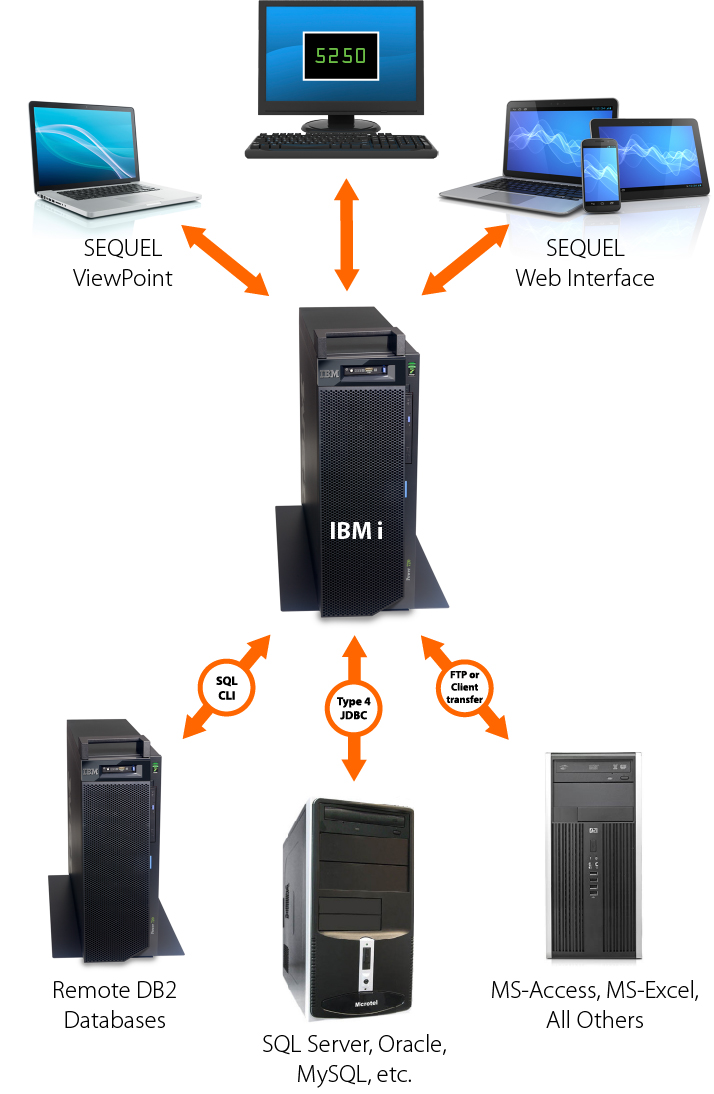Access Oracle, MySQL, SQL Server, and other databases with IBM i queries.
Where is your business data? Is it all in IBM i DB2, or do you have data in MySQL, Microsoft SQL Server, or Oracle databases? Do you need to consolidate this data across DB2 partitions? Does your current reporting and data access solution consolidate and provide instant access to this remote data? Do your developers need to move or modify data from one database to another?
There are many ways to access and consolidate the data on other platforms or partitions. Client Access, FTP, JDBC, ODBC, and several other solutions can help. The trick is to make all of the data available to your end users so they can build queries and reports without having to learn database-specific SQL for each server. Manipulating data across different databases is a big challenge for you and your IT group.
SEQUEL Handles Multi-Platform Database Access
SEQUEL supports real-time data access for remote databases across platforms. This means unprecedented data analysis for DB2, Microsoft SQL Server, Oracle, MySQL, or any other database with a suitable SQL CLI or JDBC Type-4 driver. With SEQUEL's easy?to-use interfaces—the SEQUEL ViewPoint graphical interface, a 5250 command line interface, or the SEQUEL Web Interface—drill-down data analysis, reporting, and dashboards are available across platforms (see the figure).

Figure 1: SEQUEL is a single point of access for enterprise data.
One Syntax for All
Not only can SEQUEL access DB2 databases and most JDBC type-4 databases, SEQUEL 10 can convert SEQUEL SQL to standard SQL or database-specific SQL automatically. That makes it easy to create SEQUEL views for both remote databases (such as SQL Server, Oracle, and MySQL) and the local IBM i database, using SEQUEL's easy-to-use syntax and powerful functions, such as CVTDATE and ACCUM.
You just specify SEQUEL's new SYNTAX parameter with any SEQUEL command to convert your SEQUEL SQL at run time for faster execution:
- For local IBM i access, SEQUEL converts SEQUEL SQL to standard SQL.
- For remote server access (such as MySQL), SEQUEL converts SEQUEL SQL to SQL specific for the server.
And SEQUEL 10 can query local IBM i data faster. When you specify the new *LOCALSYS value, SEQUEL uses a faster query engine (SQE) to access the database on the local IBM i server. To make view creation easier, SEQUEL SQL statements now can use unqualified file names. Behind the scenes, the *LOCALSYS value helps translate SEQUEL SQL to standard SQL and uses the job's library list.
Powerful SEQUEL capabilities, like drill-down data analysis, reporting, and dashboards, are available across platforms. For example, you can drill down from the data results on one platform to the results on another. And, with SEQUEL's versatile run?time prompting, users can provide input and customize requests, no matter what database they access.
Enterprise-Level Data Modification
We've added two new parameters, SERVER and SYNTAX, to the SEQUEL INSERT, UPDATE, and DELETE functions. They let you manipulate data on remote database servers running SQL Server, MySQL, and Oracle, making it easier than ever to use data from other databases.
You also can improve the performance on the local IBM i system. If you override existing SEQUEL views to run as SERVER(*LOCALSYS), you can use the new SQL Query Engine (SQE). For views that update large numbers of records, the performance difference can be significant.
SEQUEL Means IBM i-Centric Data Access
SEQUEL helps you modernize the look of your IBM i data and provides an IBM i-centric solution for database access. What are you waiting for? Try SEQUEL free for 30 days. You won't be disappointed.












 Business users want new applications now. Market and regulatory pressures require faster application updates and delivery into production. Your IBM i developers may be approaching retirement, and you see no sure way to fill their positions with experienced developers. In addition, you may be caught between maintaining your existing applications and the uncertainty of moving to something new.
Business users want new applications now. Market and regulatory pressures require faster application updates and delivery into production. Your IBM i developers may be approaching retirement, and you see no sure way to fill their positions with experienced developers. In addition, you may be caught between maintaining your existing applications and the uncertainty of moving to something new. IT managers hoping to find new IBM i talent are discovering that the pool of experienced RPG programmers and operators or administrators with intimate knowledge of the operating system and the applications that run on it is small. This begs the question: How will you manage the platform that supports such a big part of your business? This guide offers strategies and software suggestions to help you plan IT staffing and resources and smooth the transition after your AS/400 talent retires. Read on to learn:
IT managers hoping to find new IBM i talent are discovering that the pool of experienced RPG programmers and operators or administrators with intimate knowledge of the operating system and the applications that run on it is small. This begs the question: How will you manage the platform that supports such a big part of your business? This guide offers strategies and software suggestions to help you plan IT staffing and resources and smooth the transition after your AS/400 talent retires. Read on to learn:
LATEST COMMENTS
MC Press Online